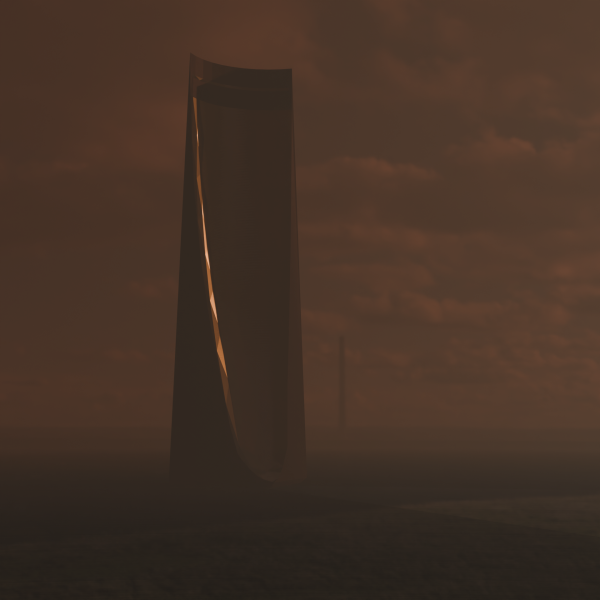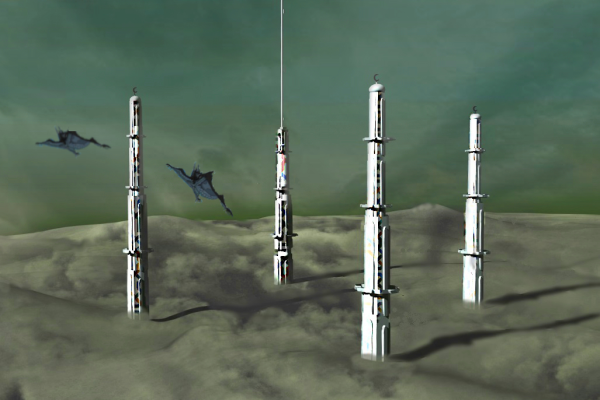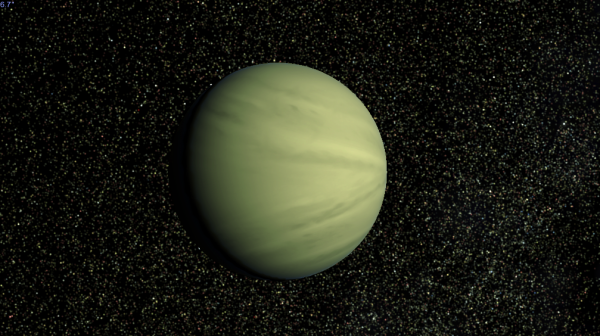BY LETTER
H'me'ch
Culture and Society > Metaphysics > Religion
Galactography > Systems and Worlds > Systems & Worlds G - H
Sophonts > Xenosophonts > To'ul'hs
Galactography > Systems and Worlds > Systems & Worlds G - H
Sophonts > Xenosophonts > To'ul'hs
To'ul'hformed world in the Stellar Umma Shell | |
 Image from Tasp | |
| A view of several skyscrapers on the surface of H'me'ch at dusk | |
History
In the mid-4700s, the nearbaseline To'ul'h H'th'h'h, at the time dwelling in Kiyoshi, converted to Islam (reverted, in Islamic terminology).By this time, H'th'h'h had been living in Kiyoshi for twenty years, investigating the Vagabond Way, the nomadic ethos/lifestyle/philosophy popular there. During his time in an Oasi community there, he made the acquaintance of a wandering imam and uttered the Shahadah (declaration of faith).
H'th'h'h claimed to have found all he had ever been looking for upon converting to Islam. He immediately turned to the study of the Qur'an and the huge quantities of Hadith which had been built up in the six thousand years since the Prophet Muhammad (pbuh) received his revelations. After months of ardent study, he decided to go back to source as much as possible, and so ultimately departed on a journey to Medina, to go on pilgrimage to the renowned virch of the Holy Cities of Islam, in the hope of gaining a deeper understanding of the context in which the Qur'an was received, and in which the Prophet lived his life. He arrived in 4793, and spent subjective months in the virch, visiting Mecca, Medina and Jerusalem. Within the virch, certain parameters were changed, enabling him to walk unprotected around the Kaaba and through the streets of the Old City of Jerusalem.
Following this time, H'th'h'h stayed on at Medina for a period, spending much time in the madrassas and the sufi schools of the desert. After a few years he left the Stellar Umma once more, so as to begin preaching to other To'ul'h. He had developed the opinion that the Prophet's lifestyle, and that of this immediate followers, was not appropriate for a sophont so different in mind and body from the Prophet. He had nevertheless decided that a non-human baseline could live a good Muslim life, first through adhering to the five pillars, and second through mapping the rationale behind the lifestyle of the Prophet, as e saw it, onto eir own life. All this was a common philosophy among Muslims of the day, and he may well have developed this opinion through conversing with other Muslims on Medina.
However, his personal extrapolation went beyond this. For H'th'h'h, for a type of sophont to ascertain how a good Muslim life was to be lived, they must discuss amongst themselves, rather than with those of very different appearances and, particularly, psychologies. It was inspired by this opinion that he aimed to convert many other To'ul'h to Islam, and generate a community which could discover how to lead a good Muslim life.
Over the course of a century, H'th'h'h traveled the well-trodden wormhole routes of the Inner Sphere, performing dawah (the work of spreading Islam). While certainly he would often engage in private conversations with individual To'ul'h or other individuals, it was his great speeches and expositions on the virtues of Islam disseminated over the Known Net which gained him the vast majority of his publicity. He set up a number of sub-sentient copies of himself, which were made available via the Known Net for people to ask questions of, although he himself made a policy not to turn down questioners seeking him directly. One of his primary emphases was on Islam's universal applicability for all sophonts. While his focus was always on To'ul'h, and derivatives of To'ul'h, he would not pass up an opportunity to preach Islam to others, and succeeded in convincing many vecs, ais, nearbaselines and tweaks to turn to Islam as well.
In 4912, having by now developed a sizable personal following among To'ul'h, H'th'h'h declared that it was time to set up a new society of To'ul'h where they could find their place in the Ummah (the universal community of Muslims), and so gathered the resources from his followers to undertake the colonisation of a new system.
The uninhabited system chosen by the group was located on the outskirts of the Umma of the Shell, and nominally claimed by it. So as to attain permission to settle the world, they petitioned the Shell's governing bodies on Zamzam, both for the rights to do so and for a ship and the necessary equipment to colonise a new world. As they were an avowedly Islamic group, who had set out to found their new society on Islamic principles, these requests were granted, and the group was able to set off towards their chosen system. While in transit, H'th'h'h made sure that all his followers were able to speak fluent Classical Arabic, which he had learnt himself while on Medina. He felt that, in discussion of matters of ancient Islamic doctrine, it was more accurate to use the Prophet's language. Of course, To'ul'h could not pronounce the phonemes required for Arabic without extensive modification, and so DNI-controlled aids were used for the purpose.
In 4998, H'th'h'h and his followers finally arrived in the target system, dubbed H'sh'l'ho'th'th, meaning Truer Submission to God in Spacer To'ul'ho'lo'ss. They immediately began to To'ul'hform H'sh'l'ho'th'th III, through the use of to'ul'hformer swarms gifted to them by the Umma. This involved the remodelling of the surface, the production of a suitable atmosphere and the import of volatiles from the asteroid belt.
While this project could certainly have been left to the to'ul'hformer swarms to complete autonomously, a number of members of the group chose to become personally involved. In particular, several members of the ai/upload contingent took it upon themselves to more closely monitor the to'ul'hforming process and conduct modifications from a few small computronium nodes in orbit and on the planet's surface. Any of the bionts present who still retained any bioborg and cyborg adaptations which had previously enabled them to adapt to lower atmospheric pressures, hostile substances, and higher light levels, shed them. Such adaptations were unneeded in their orbital colony ship, which maintained a To'ul'hl-like environment within, and would continue to be unneeded on the to'ul'hormed world.
The To'ul'hforming of H'sh'l'ho'th'th III was accelerated greatly thanks to the intervention of an SI:2 from the Umma of the Shell who offered eir services to aid in the continuing spread of the Umma(h). It was thus completed in 5042.
By the time the planet was inhabitable, several tens of thousands of individuals were ready to settle it. Around thirty thousand were To'ul'h, be they baselines, nearbaselines, rianths or tweaks, around five hundred were xenosplices, and the remaining twenty thousand were vecs and ais. All were essentially To'ul'h in their mentality, and all were Muslim. By this point the Classical Arabic spoken as a liturgical, intellectual and philosophical language in the habitat had merged with the Spacer To'ul'ho'lo'ss dialects which were generally native to the To'ul'h, as well as to an extent languages like MPA Galactic and New Martian spoken in the Inner Sphere. While pure Classical Arabic remained in its place as the language for religious discussion, the colloquial language became a kind of To'ul'hoss creole, known as To'ulrabic. It was in this language that H'sh'l'ho'th'th III was eventually renamed H'me'ch, meaning Another Haven.
Over the first few centuries, H'me'ch remained a backwater, while its population grew, and the depth of its religious studies increased. From the First Mosque-Madrassa of H'me'ch, founded upon the year of landing by Sheikh H'th'h'h, many branches sprouted, and soon great mosques and madrassas were built across the planet, as well as in orbit.
With time, many more To'ul'h-derived Muslims came to the planet, and, beginning in the 5900s, other sophonts from throughout the Umma of the Shell. By this point the H'me'ch Imam Council believed that they had found the most appropriate ways for a To'ul'h to approach the Sunnah, and had developed what they felt was a pious Muslim lifestyle on the planet, and so were confident in allowing non-To'ul'h to settle in the system. After all, there was still much to learn from each other.
During the 6000s, H'me'ch gained a great reputation through the Umma of the Shell for its great madrassas, its renowned philosophers and its well-established Islamic culture. Particularly, a great deal of hadith relating to the significance of salah (prayer) and how this relates to sophonts with such a variety of bodyplans and mentalities, is derived from H'me'ch. The gestures, poses and utterances used by humans for millennia are often impossible for a xenosophont, or indeed many provolves, vecs and so forth to imitate, and are therefore inappropriate. On H'me'ch, a great deal of thought has gone into what constitutes a valid substitute.
Of course, while it retained this strong reputation for piety and philosophy, it also developed culturally. Even from the start, there were certain MPA cultural influences, particularly among some of the ai, and it was from these cultural strands that the builders of H'me'ch's first space elevators, and later the large O'Neill cylinders in the inner system, arose. For some time there were hopes of constructing a Bishop Ring in the H'sh'l'ho'th'th system, but enthusiasm has generally abated.
 Image from Steve Bowers | |
| The New Mosque of H'mec'ch, seen from between two cloud layers. Two To'ul'hs are gliding nearby | |
H'me'ch Today
The great cities of Mek'sh't, Allah-t'th'm and Z'muth are the largest population centres of H'me'ch, all great surface metropolises with populations over sixty million. In Allah-t'th'm can be found the great New Mosque of H'me'ch, famed across the Umma of the Shell as one of the most imposing planetary structures constructed in the name of Islam. With a main structure of 4000m, the Mosque's minarets tower up another 3000m into the dense sky of H'me'ch, one of them serving as the connection for the planet's secondary space elevator, dubbed the 'Pilgrim's Path'. The New Mosque's domes are suffused with acoustic aids, inside and out. Inside to ensure that mullahs, imams or anybody else called to speak can be heard perfectly from any point in the hall and outside to allow all To'ul'h to 'see' the Mosque clearly from a great distance. Similarly, the voice of the muezzin, emanating from the highest minaret of the mosque, is amplified many times over so that it can be heard across Allah-t'th'm, calling the faithful to prayer.Around each of the densely-populated cities, and the smaller rural settlements, there are huge expanses of farmland, primarily stocked with variants on traditional To'ul'h crops and livestock. There is currently a major cultural trend among rural populations to revive the widespread use of Shur'rooss'hur for transport purposes, pushing back the more 'artificial' methods which have replaced them. For this purpose, a number of gengineers interested in To'ul'hian life have been recruited to the system, to develop new breeds of the great lumbering beasts for transporting heavy goods, for moving across water, for speed and so forth. Many of the larger Shur'rooss'hur are fitted with a form of howdah, thanks primarily to cultural influence from the nearby Jaala system. Thanks to efficient farming techniques, automation and gengineered crops and livestock, the proportion of the planet's food derived from these more traditional farming methods, as opposed to industrial food production in urban factories, is creeping up to 50%.
Thanks to its connection to the Wormhole Nexus in 8753, both Muslim and non-Muslim tourists can now freely visit H'me'ch. To'ul'h, Venusian tweaks and sophonts derived from them are highly represented among those studying Islam within its venerable madrassas. As well as matters of differences in Islamic practice in different clades, there is an increasing trend within the intellectual community of H'me'ch to look into matters relating to interfaith dialogue, and whether or not a Muslim can truly accept the validity of another's spiritual path. Opinions remain thoroughly mixed.
A council of Imams governs the planet, although any decision they make is subject to a global referendum held through the use of cyberdemocratic technologies. It is a rare day when the will of the Imams is opposed by the majority, however.
Even from the system's first settlement, when the colony ship remained in orbit for some time, it has not been only H'me'ch's surface which has been populated. To this day, there are several centres of population off-world. All four of the other planets, as well as the six moons, in the system are inhabited to some extent, almost entirely by To'ul'h-derived clades from H'me'ch, while a number of O'Neill Cylinders and computronium nodes have been constructed in the inner system. In general, these groups are culturally subsidiary to H'me'ch itself.
The language of To'ulrabic has spread beyond the world, first through secondary colonisation missions, or the establishment of H'me'ch diaspora communities throughout the Umma of the Shell, and later through its increasing role as the language of To'ul'h Muslims. On the planet of H'me'ch itself, it has produced a number of dialects, although all are still mutually intelligible. In the rural areas, there are a number of dialects which are particularly influenced by To'ul'hoss and various more obscure native To'ul'h languages, as well as, in the far north, by the constructed languages used by a number of To'ul'hian xenoprovolve clades, due to their high level of settlement in the region. Meanwhile in Allah-t'th'm, the younger people are increasingly speaking a dialect laced with Anrabic terms, due to the city's status as the hub of extensive trade and immigration from the Umma of the Shell. Mek'sh't has introduced even more Arabic influences into its particular dialect, due to its prior status as the centre of Islamic studies on the planet, while Z'muth has maintained a standard dialect, which is typically thought of as best representing Modern Standard To'ulrabic.
H'th'h'h himself ascended to the first toposophic in 6001, leaving To'ul'h existence behind, claiming to be continuing on his quest to know Allah. He disappeared from the Umma of the Shell in 6833, but recently rumours have emerged that he is preparing to convert the Muuh of the Muuh Empire to Islam, and establish the Muuh Caliphate.
 Image from Steve Bowers | |
| H'me'ch seen from space | |
Demographics of H'me'ch | |
| Total population | 4.4 billion |
|---|---|
| Nearbaseline Toulh | 42% |
| Aioids | 18% |
| Toulhmorph Terragen Vecs | 13% |
| Toulhmorph Terragen Bionts | 10.5% |
| Tweaked Toulhs | 9% |
| Xenoprovolve | 1.5% |
| Nearbaseline Human | 1.5% |
| Toulh Rianths | 1% |
| Terragen Provolves | 0.5% |
| Other | 4.5% |
| . | |
Related Articles
- Shell, The - Text by M. Alan Kazlev
The outer part of the Stellar Umma, also called the Umma Shell. - Stellar Umma, The
- Tohul (To'ul'h Homeworld)
- Tohulian Worlds
- Zamzam - Text by M. Alan Kazlev
Capital of the Shell, the outer part of the Stellar Umma.
Appears in Topics
Development Notes
Text by Kirran Lochhead Strang
Initially published on 06 February 2015.
skyscraper image by Tasp added november 29 ,2024
Initially published on 06 February 2015.
skyscraper image by Tasp added november 29 ,2024






